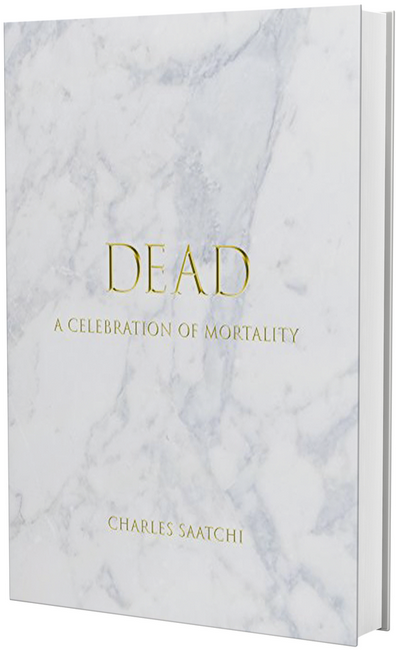
Dead – A Celebration of Mortality by Charles Saatchi
The Complete Manual of Suicide was published in 1993 and sold more than a million copies in Japan. The author, Wataru Tsurumi, explained in graphic detail how to complete your suicide effectively. The book offers 11 methods of suicide, each given a pain scale (shown by skulls) and a guaranteed lethality score. Copies have been found beside many suicide victims.
So it's a book about death with a very clear purpose. Can we say the same of Charles Saatchi's Dead – A Celebration of Mortality? Well, maybe – and if you like stories and statistics about death past and present, this will certainly entertain.
So we start in the graveyard of Yekaterinburg in the Ural Mountains, where the exotic tombstones of gangsters killed in Russian Mafia wars celebrate well-paid and exciting lives ... which were also brief and roughly ended. Turn a page and we're considering the fact that Attila the Hun, after inflicting violent death on so many, himself died of nothing more brutal than a nose bleed.
Saatchi likes such twists, just as he likes gallows humour, as offered by Cherokee Bill, the 19th-century American outlaw. He was asked by the hangman if he had any last words: "Hell no, I came here to die, not to make a speech." Freud made a study of gallows humour – it's a global phenomenon – saying, "The ego refuses to be distressed by the provocations of reality, to let itself be compelled to suffer."
Here's a book that loves information, as long as it's about death. So we learn that the box jellyfish has the most powerful venom in the world; that 200 bodies of fallen climbers remain on Everest, making it the world's highest graveyard, and that Greenland possesses the highest suicide rate in the world – one in five of the population will attempt to kill themselves at some point. (Around a million commit suicide around the world per annum, apparently.)
And what to do with the ashes of loved ones? You can throw them out to sea – but Keith Richard snorted his father's remains; rapper Tupac's band members rolled up and smoked his ashes while Denise Moon took the ashes of her late partner to court to prove she was not evading council tax.
Meanwhile climate change pessimist Professor Frank Fenner claims the human race will be extinct in 100 years due to our reckless disregard of the planet and the demands of an ever-increasing population. This may explain one of Prince Philip's lesser known public comments: "If I were to be reincarnated, I would wish to return to Earth as a killer virus to lower human population levels." So a saviour of sorts.
It's not all gloom. More than eight million Americans claim a Near-Death Experience (NDE): a sense of being outside the body watching on, a sense of peace, a tunnel, an explosion of light, a sense of unconditional love – and in more than 50% of those questioned, agreeable music. There's then the decision, often reluctant, to return to life on Earth ... heaven must wait.
There isn't much heaven in this book, however, even if we do have a chapter on how to survive a multiple stabbing. The obese Danny Ross survived 38 stab wounds due to his fat protecting his vital body organs.
And so what does it all add up to, this life and death business? Saatchi would probably say, "Not very much". His aim is wry amusement rather than hope. His closing words – in the bold font of a gravestone, to add gravitas – are: "Some lives leave a mark, others leave a stain. Almost everyone lives a life of little consequence to mankind. But wouldn't you prefer to have spent your years rather uselessly but entertainingly – even if your existence didn't achieve anything memorably significant at all?"
Anyone for a drink?
Further reading on ... the grim reaping
Stiff: the Curious Lives of Human Cadavers by Mary Roach. What happens to the bits you leave behind; both ghoulish and fascinating.
The Secret Garden by Frances Hodgson Burnett. On the death of her parents, a girl is sent to live with her uncle who is still grieving for his wife and unwilling even to meet his son for fear he'll die as well. But death's hold begins to crumble.
The Children of Men by P D James. In 2021 a bleak England is depopulating due to infertility. But a few resisters exist.
The Happy Prince by Oscar Wilde. A swallow and a statue work together to save those who are suffering in the world, but they cannot save themselves.
Uncommon Knowledge
Newsweek is committed to challenging conventional wisdom and finding connections in the search for common ground.
Newsweek is committed to challenging conventional wisdom and finding connections in the search for common ground.
About the writer
To read how Newsweek uses AI as a newsroom tool, Click here.





